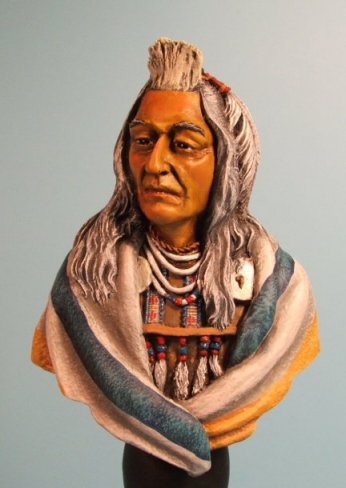- Store
- >
- Busts Asst Scales
- >
- TLB 027 200mm Crow Warrior Bust
TLB 027 200mm Crow Warrior Bust
SKU:
$36.95
$36.95
Unavailable
per item
Sculpted by Matt Springer Painted by Guy Herrick
The Crow were a very important and prominent tribe of the northwestern American plains. They were first seen by white men as late as the very early 1800’s during Lewis and Clark’s expedition. In time, the tribe actually split into two factions: the Mountain Crows who lived in the valleys of northern Wyoming and southern Montana and the River Crows who occupied territory along the Missouri and Yellowstone rivers.
Known as one of the plains most visually striking and decorated peoples, the Crow survived the white occupations with very little blood shed and signed The Laramie Treaty of 1851 with the US and subsequent Laramie Treaty of 1868 that further defined their borders and established their Reservation.
A smallpox epidemic severely reduced their numbers in the 1940’s, but they still exist and carry on many of their cultural traditions to this day.
This figure depicts a typical late, middle aged Crow Warrior with the Nez Perce influenced raised forelock of hair that was often painted white. He is wrapped in a Hudson Bay blanket in traditional fashion and exhibits many typical Crow decorations including a hawk skull head piece and two hawk/eagle coup feathers. The face can be painted with or without decoration as the painter prefers.
The Crow were a very important and prominent tribe of the northwestern American plains. They were first seen by white men as late as the very early 1800’s during Lewis and Clark’s expedition. In time, the tribe actually split into two factions: the Mountain Crows who lived in the valleys of northern Wyoming and southern Montana and the River Crows who occupied territory along the Missouri and Yellowstone rivers.
Known as one of the plains most visually striking and decorated peoples, the Crow survived the white occupations with very little blood shed and signed The Laramie Treaty of 1851 with the US and subsequent Laramie Treaty of 1868 that further defined their borders and established their Reservation.
A smallpox epidemic severely reduced their numbers in the 1940’s, but they still exist and carry on many of their cultural traditions to this day.
This figure depicts a typical late, middle aged Crow Warrior with the Nez Perce influenced raised forelock of hair that was often painted white. He is wrapped in a Hudson Bay blanket in traditional fashion and exhibits many typical Crow decorations including a hawk skull head piece and two hawk/eagle coup feathers. The face can be painted with or without decoration as the painter prefers.
